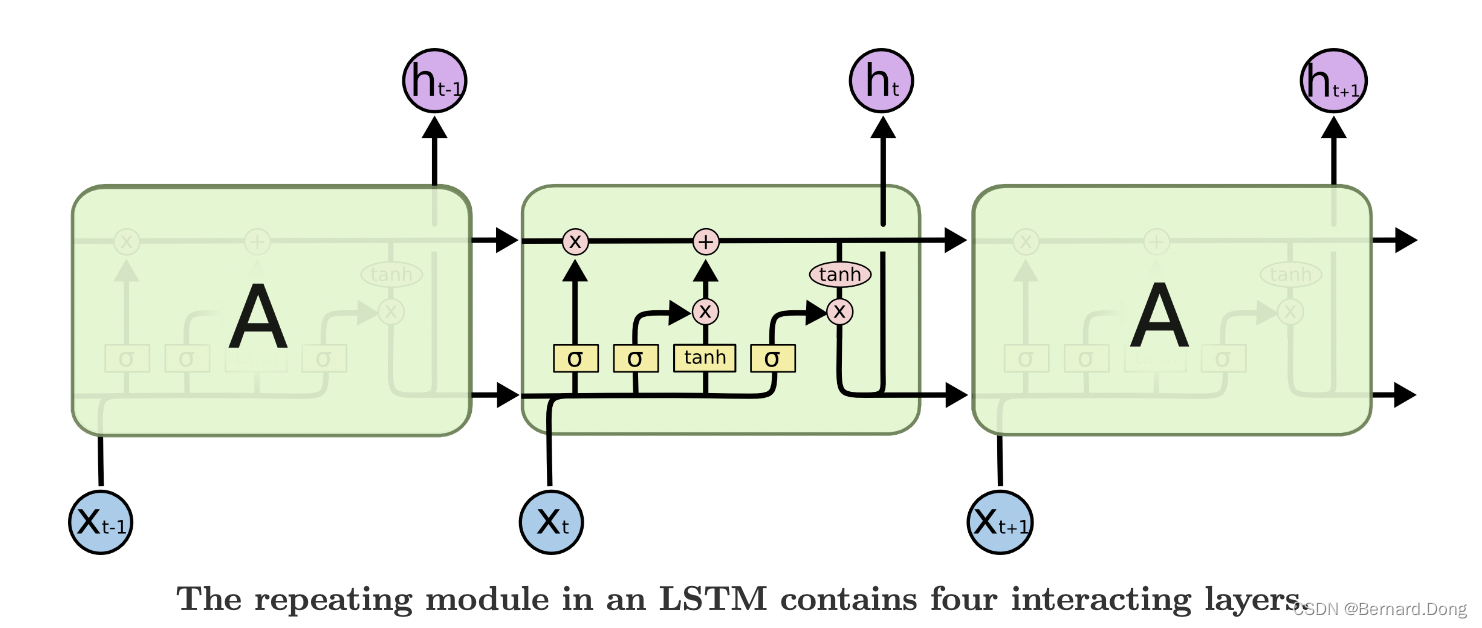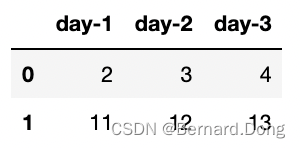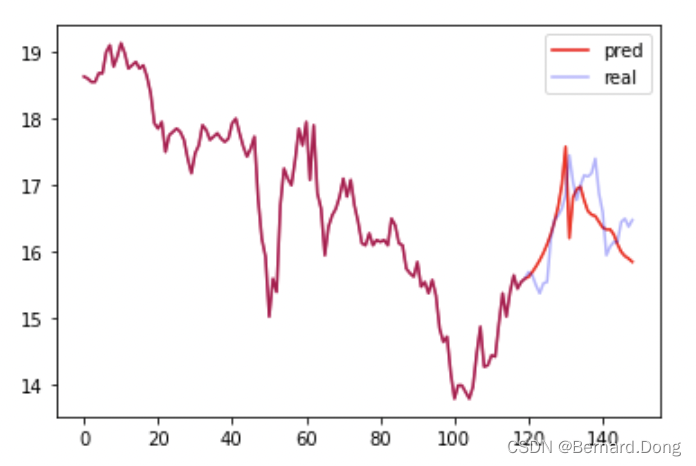文章目录
1. 背景2. 模型搭建2.1 定义LSTM2.2 LSTM层的输入和输出2.3 网络建立 3. 时序数据处理3.1 三种输入模式3.2 归一化与反归一化3.3 X和Y是什么3.4 多线模式 4. 模型训练5. 预测完整代码及数据
1. 背景
LSTM因其具有记忆的功能,可以利用很长的序列信息来建立学习模型,所以用它来进行时间序列的预测会很有优势。实际操作中利用LSTM预测有两大难点:一是模型如何搭建,二是前期的数据如何处理,我们依次介绍。本文主要参考来源于这篇文章。
2. 模型搭建
pytorch网络搭建我在之前的文章已初步介绍过,但对于循环神经网络,还有很多需要补充的部分。下图是LSTM单元的结构,每一个格子代表一个时间步(time-step),想深入了解请看LSTM单元的详细介绍。
那么在pytorch中是如何实现的呢?pytorch中的LSTM结构实现
2.1 定义LSTM
几个参数的含义为(红字是比较常用的参数):
rnn = nn.LSTM(input_size, hidden_size, num_layers )2.2 LSTM层的输入和输出
Inputs: input, (h_0, c_0)
输入的数据由两部分,一是input,也就是要输入的张量,其结构在下文中会详细介绍,二是元组(h_0, c_0),包含隐藏状态h和单元状态c的初始值,也可以不写入这一项,那么将默认为0.
Outputs: output, (h_n, c_n)
输出的除了输出值output,还包括了(h_n, c_n),即当前的隐藏状态和单元状态。
output, (hn, cn) = rnn(input, (h0, c0))2.3 网络建立
如卷积神经网络一般,网络除了卷积层还要包含全连接层,LSTM层也是如此,在LSTM后方的全连接层也可以看做是一个回归操作 regression。
LSTM+一个全连接层的简单例子:
class RegLSTM(nn.Module): def __init__(self, inp_dim, out_dim, mid_dim, mid_layers): super(RegLSTM, self).__init__() self.rnn = nn.LSTM(inp_dim, mid_dim, mid_layers) # rnn self.reg = nn.Sequential( nn.Tanh(), nn.Linear(mid_dim, out_dim), ) # regression def forward(self, x): y = self.rnn(x)[0] y = self.reg(y) return y我们的网络在此基础上做了调整,一是增加了一个线性层,且在张量进出线性区时进行了降维和恢复的操作,二是增加了一个output_y_hc()方法。
class RegLSTM(nn.Module): def __init__(self, inp_dim, out_dim, mid_dim, mid_layers): super(RegLSTM, self).__init__() self.rnn = nn.LSTM(inp_dim, mid_dim, mid_layers) # rnn self.reg = nn.Sequential( nn.Tanh(), nn.Linear(mid_dim, mid_dim), nn.Tanh(), nn.Linear(mid_dim, out_dim) ) # regression def forward(self, x): y = self.rnn(x)[0] # y, (h, c) = self.rnn(x) seq_len, batch_size, hid_dim = y.shape y = y.view(-1, hid_dim) #降维 y = self.reg(y) y = y.view(seq_len, batch_size, -1) #恢复原来的维度 return y def output_y_hc(self, x, hc): y, hc = self.rnn(x, hc) # y, (h, c) = self.rnn(x) seq_len, batch_size, hid_dim = y.size() y = y.view(-1, hid_dim) y = self.reg(y) y = y.view(seq_len, batch_size, -1) return y, hc进入线性区前的降维提高了收敛速度,而output_y_hc()方法与forward()很像,区别在于输入和输出时都包含了(h,c),这个方法主要用于训练后的预测,后面会详细说明。
3. 时序数据处理
3.1 三种输入模式
时序数据如何处理,与pytorch中LSTM层张量的输入格式有关,上文提到的input,有三种输入模式,其中
L:序列长度,就是时间长短M:输入的数据的维度,同上文input_sizeN:batch_size批次数,后面会讲到。 单线模式:数据维度(L, M)。举个例子,我们有三天,每天有两个维度的数据,那么L=3,M=2,最后要输入的是tensor([[ 2, 11],[ 3, 12],[ 4, 13]])。 多线模式一:当参数
多线模式一:当参数batch_first=False时(默认状态),数据维度为(L, N, M)。还是上图这个例子,时间点有三个,但我们想将其分为两个批次(day-1, day-2)和(day-1, day-2, day-3),所以L=3,N=2,M=2。最后要输入的如下,注意这里用pad_sequence进行了补零操作。 tensor([[[ 2, 11], [ 3, 12]], [[ 3, 12], [ 4, 13]], [[ 4, 13], [ 0, 0]]])batch_first=True时,数据维度为(N, L, M,),最后要输入的如下。 tensor([[[ 2, 11], [ 3, 12], [ 4, 13]], [[ 3, 12], [ 4, 13], [ 0, 0]]])3.2 归一化与反归一化
实践证明,如果训练前后不进行数据的归一化与反归一化处理,可能会让结果产生较大偏差。我们用MaxMin归一化方法,但要注意一点,我们的量纲,也就是最大值最小值要与训练数据保持一致。
def minmaxscaler(x):#训练数据归一化 minx = np.amin(x) maxx = np.amax(x) return (x - minx)/(maxx - minx), (minx, maxx)def preminmaxscaler(x, minx, maxx):#用训练数据的最大值最小值归一化预测数据 return (x - minx)/(maxx - minx)def unminmaxscaler(x, minx, maxx):#预测完毕的数据反归一化 return x * (maxx - minx) + minx3.3 X和Y是什么
对于时序数据,我们会有一个疑问,我们训练时的特征集和标签集是什么,或者说X和Y都是什么?
在这里我们的处理是:前一段时间作为X,后一段时间作为Y,取time_diff=1。比如我们的时间步是1 2 3 4 5 6 7,其中一个X就可以取1 2 3 4,对应的Y为2 3 4 5。
3.4 多线模式
假如原始数据为[[1,2],[3,4,5],[6,7,8,9]] ,pad_sequence()可以将其转化为多线模式一:
tensor([[1, 3, 6], [2, 4, 7], [0, 5, 8], [0, 0, 9]])pad_sequence(batch_first=False)将其转化为多线模式二:
tensor([[1, 2, 0, 0], [3, 4, 5, 0], [6, 7, 8, 9]]) 多线模式是将时序数据切割成小段进行训练,其目的是充分利用原数据的信息,我们的项目使用的也是这种模式。总体时间步有150,训练集有100,每一个时间仅对应一个值,我们定义一个长度为40的时间窗口,每隔三个时间取为一批次,一共有20批,即batch_size=20,然后将转化为多线模式一。
#数据预处理 归一化train_x, train_x_minmax = minmaxscaler(data_x[:train_size])train_y, train_y_minmax = minmaxscaler(data_y[:train_size])#转换为tensor格式train_x = torch.tensor(train_x, dtype=torch.float32, device=device)train_y = torch.tensor(train_y, dtype=torch.float32, device=device)#对时序数据进行切割、重组window_len = 40batch_x,batch_y=list(),list()for i in range(len(train_x),window_len,-3): batch_x.append(train_x[i-window_len:i]) batch_y.append(train_y[i-window_len:i]) #多线模式一batch_x = pad_sequence(batch_x)batch_y = pad_sequence(batch_y)最后得到的batch_x及batch_y的维度均为(40,20,1)对应着我们之前说的(L, N, M)。
4. 模型训练
模型训练过程与其他神经网络一致,具体如下:
# 加载模型net = RegLSTM(inp_dim=1, out_dim=1, mid_dim=16, mid_layers=2)#定义模型loss = nn.MSELoss()#定义损失函数optimizer = torch.optim.Adam(net.parameters(), lr=1e-2)#定义优化器# 开始训练print("Training......")for e in range(1000): out = net(batch_x)#向前传播 Loss = loss(out, batch_y)#计算损失 optimizer.zero_grad()#梯度清零 Loss.backward()#反向传播 optimizer.step()#梯度更新 if e % 10 == 0: print('Epoch: {:4}, Loss: {:.5f}'.format(e, Loss.item()))5. 预测
预测的思路简单来说是我们有时间步1 2 3 4 5,先预测出6,然后用1 2 3 4 5 6预测7,以此类推。可以看出这个过程每一次都需要把整个序列重新输入,但如果我们能把每一步当前的信息(h,c)储存起来,下一步就不用重复前面的步骤了。所以我们前面提到的output_y_hc()方法就是这时候使用的。
#定义初始状态zero_ten = torch.zeros((mid_layers, eval_size, mid_dim), dtype=torch.float32)#预测test_len = 40for i in range(train_size, len(new_data_x)): # 要预测的是i test_x = new_data_x[i-test_len:i, np.newaxis, :] test_x = preminmaxscaler(test_x, train_x_minmax[0], train_x_minmax[1]) batch_test_x = torch.tensor(test_x, dtype=torch.float32, device=device) if i == train_size: test_y, hc = net.output_y_hc(batch_test_x, (zero_ten, zero_ten)) else: test_y, hc = net.output_y_hc(batch_test_x, hc)# test_y = net(batch_test_x) predict_y = test_y[-1].item() predict_y = unminmaxscaler(predict_y, train_x_minmax[0], train_y_minmax[1]) new_data_x[i] = predict_y训练了几次,每次结果都不太一样,取了一个相对不错的。由于使用的是原油价格,随机性比较大,如果是规律性强的数据效果会好得多。